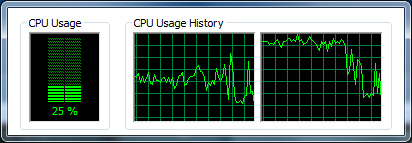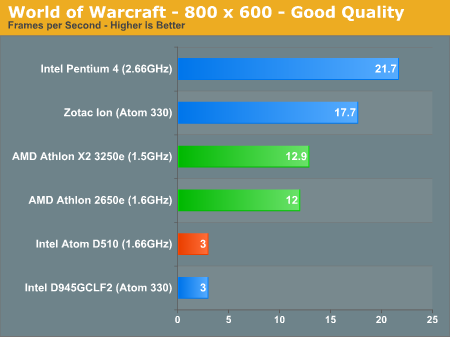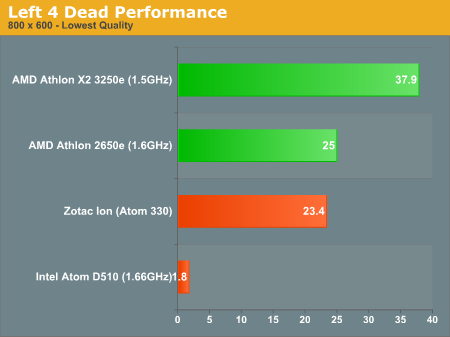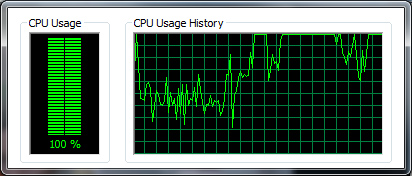AMD Athlon 2650e & X2 3250e - Better than Atom for SFF Desktops
by Anand Lal Shimpi on December 31, 2009 12:00 AM EST- Posted in
- CPUs
Platform: ION vs. Radeon HD 3200
The Dell zino HD uses an ATI Mobility Radeon HD 3200. The mobile version of the desktop 780G chipset. We already know that Intel’s default Atom chipsets can’t decode HD video and have horrible gaming performance, but what about ION vs. AMD’s integrated solution?
The first test is H.264 decode acceleration. I fired up the latest version of Media Player Classic and tested x264 acceleration.

On a single core Athlon 2560e CPU utilization while playing back 13Mbps 1080p content ranged between 40% and 65%. Throw on the dual core X2 3250e and the numbers drop down into the 20% - 40% range.

Playable? Absolutely, with CPU power to spare.
Gaming Performance
Next up is gaming. Intel’s integrated graphics can’t play games at all with Atom, but ION definitely can. I fired up our World of Warcraft benchmark:

Hmm, that’s unexpected. ION + Atom is actually a bit faster than the 2650e and AMD’s integrated Radeon HD 3200. It’s a noticeable advantage. Neither is exactly smooth but the advantage here goes to ION.
Next up I tried Left 4 Dead and the roles reversed:

The 2650e was slightly faster than the Atom 330 + ION combination, but the dual core Athlon X2 3250e was clearly in the lead.
Overall it’s clear that ION, even while hampered by Atom is a potent little solution. And it’ll take more than just the Athlon 2650e to be noticeably faster in games across the board.
Flash Acceleration
I tested Flash 10.2 acceleration but was unfortunately met with the same problems I originally had in my GPU Accelerated Flash 10 article. With a 1280 x 720 desktop resolution full screen Hulu (480p) was smooth but took up 100% of the Athlon 2650e. If I scaled the desktop res too much higher I started to drop frames. Flash video in a window played just fine with manageable (but not low) CPU utilization.

This was a clean install of Windows 7 x64, so I’m not quite sure what’s going on here. Granted Flash 10.x is still in beta and perhaps there are still kinks that have to be worked out.
Flash is playable on the 2650e/3250e + Radeon HD 3200, and with the right hardware/driver combo it’ll work even better, but I’ve just had better experiences with ION in that regard.










40 Comments
View All Comments
Penti - Tuesday, January 5, 2010 - link
But retard, he tested the solution people use to playback H.264 material encoded with x264 (homebrew encoder) and put into an MKV container. So it's still valid as he didn't test another solution that would probably have problems with it. He tested the built in decoder (not x264 but FFMpeg with modifications) in MPC-HC thus the test is valid. He didn't do a blu-ray playback test that would have been different (higher bitrate, MC and iDCT done in hardware plus decryption of the disc). -- He did test x264 warez playback as that is what all people would use rather then legally bought BDs or pirated un-rencoded BDs. He also did do a x264 encoding test. (All the diagrams referring to x264 is referring to testing the x264 software encoder, but in Page 3 he tests MKV x264-encoded h264 decode acceleration in MPC-HC. Which is specific as it uses a different decoder solution and doesn't fully offload to the hardware. Only bitstream so its as said very relevant to the readers.)People use warez, Anand use warez, the readers use warez get in with the game. Just a MKV-splitters usually results in lousy unwatchable playback. But more importantly this is the solution people uses. So testing it as something differentiated from something produced by commercial encoders in standard containers is valid. When testing BD playback your testing the BD-player (PowerDVD, WinDVD, Arcsoft TotalMedia Theatre) It will differ with choosing a different one, there can be performance problems in one but not the other. You can remux a H.264 bitstream from a commercial codec too, but who cares. He's testing what people use. As other solutions are feature incomplete.
nubie - Saturday, January 2, 2010 - link
I am way ahead of them already, I have two of my desktops converted to Turion ML-30s (1.6ghz 1MB level 2 cache).Mostly for the silence, partly for the low power draw.
They cost $10 (for both, $5 apiece) on ebay.
You can lower their voltage using RightMark CPU utility.
Just pick up a Socket 754 motherboard and a mobile 754 chip. The only real work is modifying the heatsink to fit a processor without the integrated heatspreader.
If you want to do this on the cheap that is (I know, it is a DDR1 platform, but eh, the price is right.)
Oberst - Friday, January 1, 2010 - link
Hello and a happy new year to all,what mobo did you use for the AMD cpus? The Zino HD only uses cpus that have a tdp of 22W or less, so there is probably only a one- or two-phase vrm. But even µATX mobos with 780g often support 140W cpus, so the vrms will not be very efficient at 22W. So the AMD systems will get nearer to the Atom when using a dedicated mobo. I hope dell did so and made a dedicated mobo for these low power cpus.
Also the price is quite cheap (at least in Germany). The HD is 20€ more expensive than the standard Zino. The CPUs are both 1,6GHz (Atom 230/2650e) but the HD has double Ram (2GB), double hdd (320GB) and Win7 (home64) instead of XP (home32).
So compared to the standard Zino the Zino HD seems to be the better choice.
KidneyBean - Friday, January 1, 2010 - link
I suppose now that the ATX 2.3 spec requires 80% efficiency at 20% of the rated power supply, we can just use 300W power supplies for these low power systems, but I thought I'd share a link to an interesting power supply manufacturer that makes 80-150W power supplies. The great thing to me is that they are completely fanless.http://www.mini-box.com/DC-DC">http://www.mini-box.com/DC-DC
I would love to hear if anyone knows of any more silent power supplies for these low power systems.
strikeback03 - Monday, January 4, 2010 - link
I tried to use an M3-ATX (a version of the picoPSU) in my carputer using the LF2 board (Atom 330), but it didn't last too long, from other forum reports the 5V draw is too high. That is likely to be a complication with any of those PSUs, needing to know with more detail than usual what power is being drawn from where.KidneyBean - Friday, January 1, 2010 - link
Seems to me we don't need to buy these CPU's. We could get ~2.7GHz AMD K8/K10 CPU's and underclock/undervolt them. Would get us similiar power usage. Maybe a little higher, since AMD might bin these low power CPU's specifically for this purpose.Is it not possible to underclock/undervolt AMD CPU's to these speeds and voltages? Last I heard AMD doesn't clock lock below the default multiplier.
Interesting review nonetheless. I think I'll go take a look at that interesting OCZ DDR3 advertisement.
Kobaljov - Friday, January 1, 2010 - link
The power consumption of the old Atom 230 is a little bit strange, compared to the 330 and the Pineview both in idle and load, there is not enough difference which indicating the other core (1 Atom core is about 6 W as I remember). At the x264 HD playing the CPU load on the Atoms was 100% ?Other issue with the AMD CPUs is the cooling as both models needs active cooling and the dual core probably needs a normal (not brick) power supply which uses fan too, the necessary size and the noise can be bigger than the Atoms (the new dual core Pineview on the Intel's mobo runs with passive heatsink and with the Broadcom Crystal HD chip it can handle the video acceleration)
mindless1 - Wednesday, January 6, 2010 - link
It is not an issue, even the X2 AMD CPU could be passively cooled with an appropriately designed heatpipe. Recall that desktop video cards with higher TDP are also passively cooled.Further it is not a safe assumption that a brick PSU would be beyond it's limits, recall that laptops not only run off of one but recharge a battery while doing so and with far more power hungry CPUs than those including powering the LCD display.
However, I for one would like at least a very low RPM 60-80 x25mm thick fan in such a box even if it needed a few centimeters increase in size to have one. That could be inaudible and likely to increase the product lifespan. If they then wanted to duct that exhaust fan's intake across a passive CPU and/or chipset 'sink too, I'd be fine with that so long as they used a decent quality fan instead of the low end sleeve bearing junk too often seen in low cost equipment.
signorRossi - Friday, January 1, 2010 - link
Does the desktop Pineview even provide HDMI? If not it is not really suited for a HTPC system. And doesn't it also have the same crappy dual-monitor capabilities as the mobile version?Kobaljov - Friday, January 1, 2010 - link
Yes, the HDMI is really missing, I hope that maybe other motherboard companies can and will include it soon (I don't know that it's supported by the chipset or no)